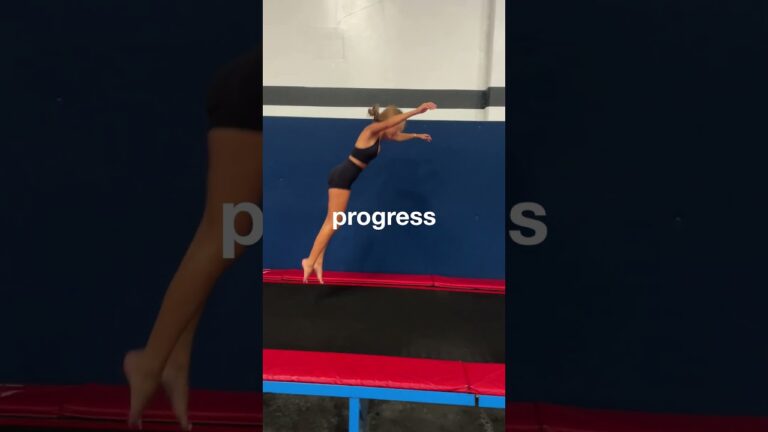[ad_1]
Learning a backflip in under 10 minutes is highly unlikely and potentially dangerous. While it’s possible to understand the concept of a backflip and perhaps even attempt a poorly executed one in that time, mastering the skill safely and effectively takes considerably more time, practice, and proper instruction.
Here’s a breakdown of the steps involved in learning a backflip, and why it’s improbable to achieve proficiency in just 10 minutes:
1. Foundational Strength and Flexibility (Time Investment: Weeks to Months):
- Core Strength: A strong core is crucial for controlling your body rotation and landing safely. Exercises like planks, Russian twists, leg raises, and crunches are essential.
- Leg Strength: Powerful leg muscles are needed for generating the necessary height and momentum. Squats, jump squats, lunges, and box jumps are beneficial.
- Back Flexibility: Sufficient back flexibility allows for a smoother and more controlled backward arch. Back extensions, bridges, and stretching exercises targeting the back are important.
- Shoulder Flexibility: Shoulder flexibility impacts your ability to bring your arms over your head and assist with the rotation. Stretches like arm circles, shoulder rolls, and wall slides are helpful.
- Wrist Strength: Wrist strength is important for supporting your bodyweight during landing. Wrist extensions, wrist curls, and pushups on your fists can help build strength.
2. Prerequisite Skills (Time Investment: Days to Weeks):
- Standing Back Tuck: A fundamental tumbling skill that involves tucking your knees to your chest and rolling backward in a tight ball. This helps develop a sense of backward rotation. Practicing on a soft surface like a mat is recommended.
- Back Handspring: Although not strictly required, a back handspring greatly aids in building confidence and understanding the body mechanics of going backward. It involves a jump backward, placing your hands on the ground, and pushing off with your arms to land on your feet.
- Jumping Backwards: Practicing jumping backwards repeatedly helps familiarize you with the sensation of moving backward and improves your spatial awareness.
- Proper Landing Technique: Learn how to land safely with bent knees, absorbing the impact and preventing injury. Practice landing from small jumps.
3. Backflip Progression (Time Investment: Weeks to Months):
- Spotting: This is the most critical step. A qualified spotter, preferably an experienced gymnast or coach, provides physical support and guidance, ensuring your safety throughout the backflip attempt. The spotter helps you maintain proper form, provides assistance if you lose balance, and helps you complete the rotation.
- Backflip Drill with Spotter: With the spotter’s assistance, practice the backflip motion. The spotter will guide you through the jump, tuck, and rotation, ensuring you stay on track.
- Drill with Spotter (minimal support): Over time, the spotter will reduce their level of assistance as you become more comfortable and confident.
- Backflip onto a Soft Surface (e.g., Mats, Trampoline): Gradually progress to practicing the backflip onto soft surfaces. This allows you to experiment with the technique without the fear of a hard landing. A trampoline can also help build air awareness.
- Backflip to Standing: Begin attempting the backflip to a standing position on a soft surface with a spotter. Focus on generating enough height and momentum to complete the rotation.
- Independent Backflip: Once you are consistently landing the backflip on a soft surface with proper form, and with the spotter’s approval, you can start practicing it independently on a soft surface.
- Practice on a Firm Surface: Only after you have mastered the backflip on a soft surface and you feel fully confident should you attempt it on a firm surface, always with a spotter initially.
4. Refinement and Consistency (Time Investment: Months to Years):
- Continuous Practice: Regular practice is essential for maintaining and improving your backflip technique.
- Video Analysis: Record yourself performing the backflip and analyze the footage to identify areas for improvement.
- Professional Coaching: Working with a qualified gymnastics or acrobatic coach can provide personalized feedback and guidance, helping you refine your technique and prevent injuries.
Why 10 Minutes is Unrealistic:
- Muscle Memory: Developing muscle memory for a complex movement like a backflip requires repeated practice over a sustained period.
- Air Awareness: Learning to orient yourself in the air takes time and experience.
- Fear Factor: Overcoming the fear of going backward is a significant hurdle for many people, and it cannot be rushed.
- Physical Conditioning: The body needs to be physically prepared for the demands of a backflip. Strength, flexibility, and coordination take time to develop.
- Safety Concerns: Attempting to learn a backflip too quickly increases the risk of serious injuries, such as sprains, strains, fractures, or head trauma.
In conclusion, learning a backflip is a process that requires patience, dedication, proper instruction, and a gradual progression. It is highly improbable to achieve proficiency or even attempt it safely in under 10 minutes. Safety should always be the top priority. Seek guidance from experienced professionals and prioritize proper training over speed.
[ad_2]

